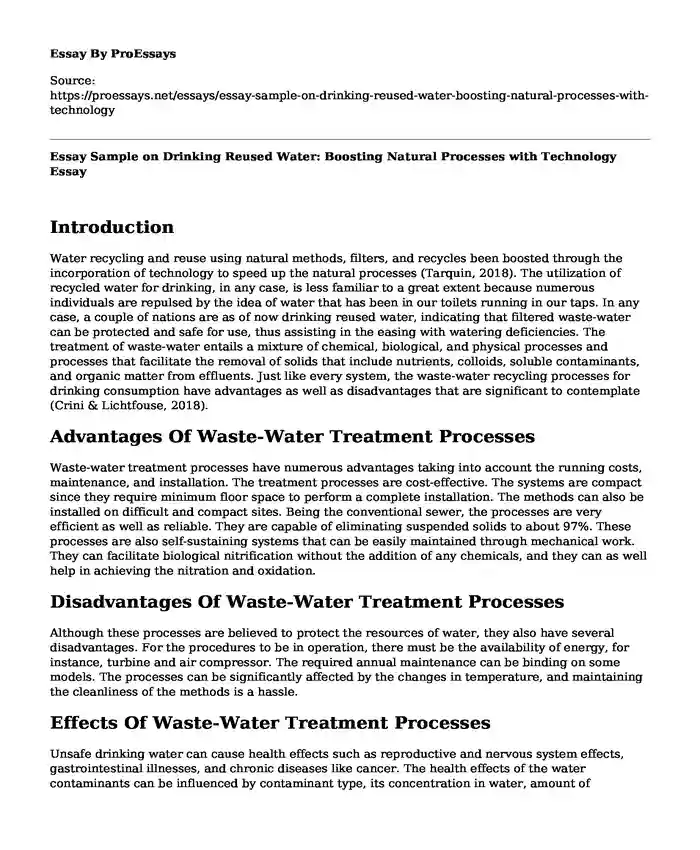Introduction
Water recycling and reuse using natural methods, filters, and recycles been boosted through the incorporation of technology to speed up the natural processes (Tarquin, 2018). The utilization of recycled water for drinking, in any case, is less familiar to a great extent because numerous individuals are repulsed by the idea of water that has been in our toilets running in our taps. In any case, a couple of nations are as of now drinking reused water, indicating that filtered waste-water can be protected and safe for use, thus assisting in the easing with watering deficiencies. The treatment of waste-water entails a mixture of chemical, biological, and physical processes and processes that facilitate the removal of solids that include nutrients, colloids, soluble contaminants, and organic matter from effluents. Just like every system, the waste-water recycling processes for drinking consumption have advantages as well as disadvantages that are significant to contemplate (Crini & Lichtfouse, 2018).
Advantages Of Waste-Water Treatment Processes
Waste-water treatment processes have numerous advantages taking into account the running costs, maintenance, and installation. The treatment processes are cost-effective. The systems are compact since they require minimum floor space to perform a complete installation. The methods can also be installed on difficult and compact sites. Being the conventional sewer, the processes are very efficient as well as reliable. They are capable of eliminating suspended solids to about 97%. These processes are also self-sustaining systems that can be easily maintained through mechanical work. They can facilitate biological nitrification without the addition of any chemicals, and they can as well help in achieving the nitration and oxidation.
Disadvantages Of Waste-Water Treatment Processes
Although these processes are believed to protect the resources of water, they also have several disadvantages. For the procedures to be in operation, there must be the availability of energy, for instance, turbine and air compressor. The required annual maintenance can be binding on some models. The processes can be significantly affected by the changes in temperature, and maintaining the cleanliness of the methods is a hassle.
Effects Of Waste-Water Treatment Processes
Unsafe drinking water can cause health effects such as reproductive and nervous system effects, gastrointestinal illnesses, and chronic diseases like cancer. The health effects of the water contaminants can be influenced by contaminant type, its concentration in water, amount of consumed water, duration of exposure, and individual susceptibility.
Consuming water health effects with the disease-causing microbes are the waterborne diseases that pose a threat to life. These microbes may include cholera and typhoid fever. They cause more common illnesses like hepatitis, stomach pain, kidney failure, diarrhoea, and vomiting. The health effects of chemical exposure through drinking contaminated water can lead to either short or long term health effects. High exposure to chemicals can result in discoloration of the skin or more severe complications like reproductive effects, nervous system, or organ damage. Low dose exposures over a long period can lead to chronic disorders or cancer. These health effects are life threatening, thus negatively affecting individual normal life.
Conclusion
Viability investigations are significant in making resolutions for the application of water recycling treatment schemes. Most approaches of cost analysis have a habit of focusing on internal cost whereas neglecting external effects. A few project proportions are feasible economically when internal cost analysis is considered while the external cost analysis benefits are financially viable in all incorporated projects (Sancho, 2016). Therefore, the cost analysis of waste-water reuse projects for drinking ought to quantitatively evaluate the environmental, economic, and availability of the resources.
References
Crini, G., & Lichtfouse, E. (2018, July 31). Advantages and disadvantages of techniques used for waste-water treatment. Environmental Chemistry Letters. https://link.springer.com/article/10.1007/s10311-018-0785-9/tables/1.
Sancho. (2016). Cost-benefit analysis of water-reuse projects for environmental purposes: A case study for Spanish waste-water treatment plants: Request PDF. ResearchGate: Journal of Environmental Management. https://www.researchgate.net/publication/51585015_Cost-benefit_analysis_of_water-reuse_projects_for_environmental_purposes_A_case_study_for_Spanish_wastewater_treatment_plants.
Tarquin. (2018). Water Reuse Technology. https://www.waterworld.com/drinking-water/treatment/article/14070801/water-reuse-technology.
Cite this page
Essay Sample on Drinking Reused Water: Boosting Natural Processes with Technology. (2023, Sep 25). Retrieved from https://proessays.net/essays/essay-sample-on-drinking-reused-water-boosting-natural-processes-with-technology
If you are the original author of this essay and no longer wish to have it published on the ProEssays website, please click below to request its removal:
- Research Paper on Mobile Applications in the Hotel Industry
- Electric Cars Will Be the Future of America Essay
- Research Paper on Indian Ocean Pollution
- Essay Sample on Ice Storm 1998: Unprecedented Impact & Meteorological Evolution
- Essay Example on Pollution from Plastics: A Growing Threat to Ecosystems
- Essay Sample on Ogallala Aquifer: Lifeblood of 8 States in the Plains
- Unraveling Climate Change: Impact on Weather, Cryosphere, Ocean Ecosystems, and Human Society







